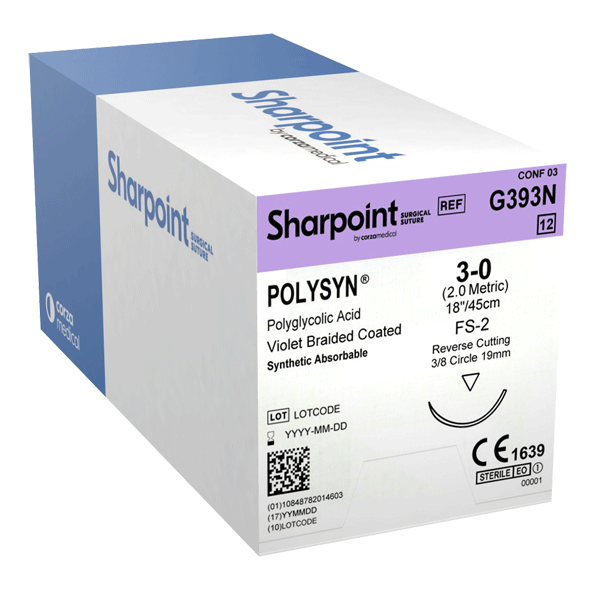Dissolvable stitches come in various colors such as yellow, violet, green, and white but it depends on the type of material the sutures are made of. Manufacturers intentionally made different suture materials to have a different corresponding color so they are more readily identifiable for clinicians.

Table of contents:
Dissolvable stitches color chart

As you can see, each type of suture material has a corresponding color. The diagram even has non-absorbable sutures to give you an idea of the contrast.
Dissolvable Suture Material | Stitches Color |
|---|---|
Gut/Catgut/Chromic | Yellow-Gold |
Polyglycolic acid (Polysyn) | Violet |
Polyglactin 910 (Vicryl) | Violet or White |
Polydioxanone (PDS) | Violet |
Polytrimethylene carbonate (Maxon) | Green or White |
Glycomer 631 (Biosyn) | Violet |
Polyglytone 6211 (Caprosyn) | Violet or White |
Poliglecaprone (Monocryl) | Violet or White |
What color are dissolvable stitches?
If the colors are a little hard to differentiate in the schema above, there is an alternative way to identify the color. We're going to provide pictures of each suture type in their box so that you can see what color they come in. It doesn't get any easier than that.
Note: Some of them do come in an undyed variation where they'll look white. Also if they dissolve, they may change to an off-white color during the dissolution process.
Surgical gut or catgut
The color of gut sutures range from a light yellow to a darker gold/bronze color.
Type of Gut Suture | Color |
|---|---|
Fast absorbing gut | Light yellow |
Plain gut | Yellow |
Chromic gut | Gold/Dark yellow |
This type of material is all natural because they're made out of the intestinal lining of ruminant animals (cows, goats, sheeps). They also happen to be the most common type to be used for wisdom teeth stitches.
Chromic gut unboxing video
The color of chromic gut sutures looks dark gold or dark yellow. You can even describe it as bronze in color. Nonetheless, the color looks very similar to what the color strip on the box is. These are widely used in dentistry, especially if you're going to have wisdom teeth removed. They are the first choice for dentists especially in the US.
Polyglycolic acid (Polysyn)
Polyglycolic acid (PGA) or polysyn stitches have a violet color and they're synthetically made but they're still absorbable. The box labels them as violet braided coated.
PGA unboxing video
Polyglactin 910 (Vicryl)
Polyglactin or more commonly known as Vicryl sutures are typically violet in color but you can also call them purple. Although they are also available in an undyed color of white.
Polydioxanone (PDS)
Polydioxanone stitches (PDS) come in a deep violet color. For some reason the color on their box is grey but the suture itself is a dark purple. They do list it as a "violet monofilament" on the label to prevent confusion.

Polytrimethylene carbonate (Maxon)
Polytrimethylene carbonate sutures or otherwise known as Maxon, is green in color. Yes, the box color does have it has grey but we know for a fact that it is dyed by green DG#6.

Glycomer 631 (Biosyn)
Glycomer 631 or Biosyn sutures are VIOLET in color. The box is red but the actual color is violet according to Covidien.

Polyglytone 6211 (Caprosyn)
Caprosyn sutures can be either violet or come undyed.

Poliglecaprone (Monocryl)
Monocryl stitches typically come in a violet color but they can also be undyed.
How to figure out if your stitches are dissolvable
The best way to identify what you have is by comparing the color of your stitches to what we have listed in the previous section. If the color looks the same then that is probably what it is.
How to identify dissolvable stitches:
Go to a well lit room.
Take a picture with flash on with your cell phone or camera.
Compare the taken photo with the listed dissolvable sutures.

Alternatively you can always give your dentist a call and the receptionist can look in your notes to see what they used. If you don't recognize the color of your stitches, you may have a non-dissolvable one.
Dissolvable suture colors in the mouth
For the mouth, the most commonly used dissolvable stitches by dentists would be the chromic gut and vicryl. That means if you see a gold (chromic gut) or purple (vicryl) stitch, it most likely means that you have a self-dissolving one.

If that is the case, you can expect them to last about 1-2 weeks in the mouth before falling out. If you have some other color, it could be a non-dissolving one.
Common wisdom teeth stitches color
The two most common colors for dissolvable wisdom teeth stitches are gold and purple. Although based on our experience, you'll most likely have gold colored sutures rather than purple ones. That's just the preference of the majority of dentists, including us.

Takeaway
The color of the dissolvable suture will depend on the material that they're made of. Most of them are violet in color with the exception of gut sutures (yellow/gold) and Maxon (green). Although some of them can come undyed which means they'll look white in color!
If yours are self-dissolving it means that you don't need a suture removal appointment. If you wait long enough, they'll fall out all on their own at least that is what our dentists in Long Island City see.
















